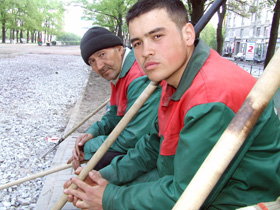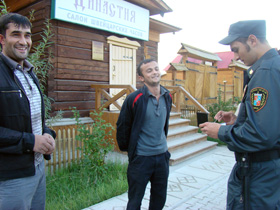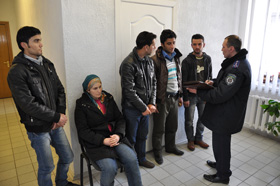Eurasian Union and Migration
Migrant workers carry a replica of Russian
painter Ilya Repin's "Reply of the Zaporozhian
Cossacks to Sultan Mehmed IV of the
Ottoman Empire" in downtown Moscow
(no votes) |
(0 votes) |
Ph.D., Professor of World Politics Department, Moscow State University
The CIS countries’ joining the Eurasian Union will lead to changes in the migration management principles in the region and increase the number of legal migrants to Russia. This will result in considerable advantages for employers and foreign workers, while also increase the risks of social destabilization. What will be the consequences of such scenario for the Russian labor market and society?
The CIS countries’ joining the Eurasian Union will lead to changes in the migration management principles in the region and increase the number of legal migrants to Russia. This will result in considerable advantages for employers and foreign workers, while also increase the risks of social destabilization. What will be the consequences of such scenario for the Russian labor market and society?
The Agreements on the Common Free Market Zone (CFMZ) of Russia, Kazakhstan, and Belarus came into force on 1 January 2012. According to the Russian leaders, the common free market zone is open to other countries wishing to join it, particularly to the CIS member states. As emphasized by President Vladimir Putin in the article “New Integration Project for Eurasia is future that is being made today” Russia’s strategic priority is the creation of the Eurasian Union, a powerful supranational union providing a zone for free movement of goods, services, capital, and labor force.
The formation of the common labor market is one of the most controversial issues in the process of regional integration. Despite having maintained a visa-free regime with regard to the CIS member states after the collapse of the Soviet Union, Russia has always followed a protectionist policy with regard to the labor market. To guarantee employment opportunities to the Russian citizens, the government has limited the number of foreign workers employed in Russia with quotas, which in the recent years have not exceeded 3% of the entire labor force. Additional medical examination requirements and ban on participation in certain types of activities have been introduced with regard to foreign workers; at the end of 2012, there are plans to introduce a mandatory Russian language exam, Russian history and principles of Russian legislation for foreign workers (with the exception of highly qualified specialists).
The formation of the common market will mean a radical change in the approach to immigration management in the region. Russia will not only lose the possibility to impose any institutional restrictions on immigration within the common free market zone, it will also have to take the obligation to ensure equal rights with regard to employment, wages, and other social and legal guarantees to the citizens of the member states. Medical records and school diploma requirements will only apply to immigrants from third countries. What will be the consequences of such scenario for the Russian labor market and society?
Migration Scale
Creation of the Common Free Market Zone (CFMZ) with Belarus and Kazakhstan will not result in any noticeable changes for the Russian society and labor market. Citizens of Belarus have previously had the right to free employment within the Union State of Russia and Belarus. Compared to the flow of immigrants from other CIS countries, the number of migrants from Kazakhstan has been relatively insignificant in the recent years (see Table 1). The approximate total number of labor migrants from Belarus and Kazakhstan is three hundred thousand people per year, which is less that one-tenth of labor immigration from the CIS member states (including illegal migrant workers). In terms of the GDP level, these countries are approaching the level of Russia’s GDP, which decreases the potential for emigration to Russia and increases the number of migrants returning to their native countries (according to the World Bank), the 2011 GDP per capita was $10.4 thousand in Russia, $9.1 thousand in Kazakhstan, and $5.7 thousand in Belarus).
Table 1.Migration from CIS Countries to Russia
| Country | Migrant Workers Granted Employment Permits in 2010, ~Thousand | Illegal Migrant Workers, Thousand (Expert Assessment) | Migration Gain in 2001-2010, Thousand (Persons Arriving Minus Persons Departing) |
|---|---|---|---|
| Belarus | 70 | 100–200 | – 1 |
| Kazakhstan | 10 | 30–60 | 316 |
| Tajikistan | 270 | 500–700 | 109 |
| Kyrgyzstan | 120 | 200-500 | 157 |
| Uzbekistan | 500 | 700–1200 | 307 |
| Ukraine | 170 | 500–1000 | 221 |
| Armenia | 60 | 600–700 | 154 |
| Turkmenistan | 10 | - | 39 |
| Azerbaijan | 40 | 400–600 | 98 |
| Moldova | 70 | - | 90 |
| Total | ~1.3 mln | ~3 – 5 mln | ~1.5 mln |
Source: Information Provided by FMS (the Federal Migration Service), Rosstat (the Federal State Statistics Service), and EDB (the Eurasian Development Bank).
The inclusion of Kyrgyzstan and Tajikistan, the next most likely candidates to join the common free market zone, will lead to much more significant changes. Currently, labor migrants from these two countries and Uzbekistan account for over half of all foreign workers employed in Russia. These countries’ per capita GDP is about ten times less than that in Russia and Kazakhstan, and, on the whole, these countries’ economy functions largely due to labor force export. According to the World Bank, money transfers account for as much as one-fifth (Kyrgyzstan) to one-third (Tajikistan) of the gross domestic product in the region’s countries.
Opening Russia’s labor market will inevitably lead to an increase in the number of legal labor migrants – both due to the legalization of temporary migrant workers employed in the informal sector and the involvement of larger numbers of residents from the sending countries in migration processes. According to estimates of the Eurasian Development Bank experts, taking into account the Russian labor market requirements, the number of legal labor migrants from Kazakhstan may increase by 50 thousand people, from Kyrgyzstan – by 360 thousand people, and from Tajikistan – by 890 thousand people.
Lending more flexibility to the labor market and meeting the labor force demand more effectively can be considered positive consequences of the common free market zone creation.
In our opinion, the above figures will in fact be less by at least one-third, since the availability of legal employment opportunities does not necessarily mean that migrants will want or be able to take the opportunities offered. The fact that Russia is not the only center of gravity for migrants from Central Asia should also be taken into account; a considerable part of the migrant flow will be redirected towards itself by Kazakhstan. According to our estimates, joining the CFMZ will entail an increase in legal immigration from Tajikistan and Kyrgyzstan by 0.7-1 million people, and by the same number – from Uzbekistan.
Open borders will allow keeping the temporary nature of foreign workers’ employment in the short-term perspective; however, taking into account the wide gap between the social-economic development of the region’s countries, the formation of more predictable and safer migration routes will lead to the creation of stable emigration channels in the future. The scale of continuous emigration to Russia will depend on the following factors: a) the development dynamics in the migrants’ countries of origin, including political and interethnic conflicts, humanitarian crises, climatic changes, etc., and b) Russia’s policy with regard to granting permanent resident status and Russian citizenship: the more liberal the policy, the larger the scale of continuous immigration.
Positive Consequences
The obvious risks involved in this scenario are connected with the escalation of social tension due to xenophobia and interethnic conflicts resulting from the officially mandated increase in immigration influx.
Lending more flexibility to the labor market and meeting the labor force demand more effectively can be considered positive consequences of the common free market zone creation. Even today, despite the 1.7 million quota restriction, there are approximately 5-7 million foreign workers in Russia: it is obvious that such a scale of labor migration can only be driven by the existing market demand. The overly strict laws do not allow many workers and employers to legalize their employment relations, forcing them to use the services of middlemen or give bribes in cases of labor law compliance inspections.
One of the key obstacles is obtaining employment permits within the framework of the yearly employment quotas. Their number is determined based on the employers’ requests approximately a year prior to the commencement of employment, which complicates the participation of small- and medium-size businesses in this process: it is rather difficult to predict the business’ need in one or two construction workers or janitors a year ahead of time. Besides, the number of employers’ requests is approved on the regional and federal levels, which allows officials tomanipulate figures at their discretion, without taking into account the actual market requirements.
Secondly, labor migrants’ legalization will allow increasing the tax levies and quality of services and goods produced by labor migrants. According to the Federal Migration Service, the state budget loses approximately 40 billion rubles due to the informal nature of labor migrant employment. Besides, transfer to the legal status will allow increasing the production quality and production standards compliance control, which both the employees and the final product consumers will benefit from.
Thirdly, effective solutions to demographic problems can be considered the long-term advantage of the common market creation. Immigration has already compensated for approximately half of the natural demographic losses suffered over the past two decades (approximately 6 mln out of 13 mln), and, according to experts’ estimates, it will remain the key resource for maintaining the active-age employable population balance in the future. By 2025, the number of active-age employable people will have decreased by 10 million, and approximately two-thirds of this number, according to optimistic forecasts, may be compensated for by migrant workers.
Negative Consequences
The obvious risks involved in this scenario are connected with the escalation of social tension due to xenophobia and interethnic conflicts resulting from the officially mandated increase in immigration influx. Even today, the majority of the population considers the current migration level too high: 68% support restrictions on the influx of migrants to the country, while only 24% support the current migration level. The increase in the number of legal foreign workers in the country by hundreds of thousands will have a radicalizing effect on the anti-migration and far-right groups of the country’s population, as well as intensify support of the anti-government protests.
One of the reasons of the local population’s discontent will be the worsening in the situation of Russian workers. In experts’ opinion, Russian employment protection institutes are essentially ineffective: strict labor laws are compensated for by lax enforcement of the laws. The institutional weakness will not allow preventing sharp declines in wages and layoffs of local workers when less expensive legal foreign labor force is available. Immigration will have the most powerful replacement effect in the sectors where employment relations are least formalized and workers are most vulnerable (primarily, trade, agriculture and transportation services sectors).
The formation of the common market will allow distributing the region’s labor force more effectively and lending more transparency to the nature of employment relations, which will result in growth of fiscal revenues and decrease in corruption and breach of law.
Expanding access to social security benefits for migrants will become the target for criticism. The Agreement on Legal Status of Migrant Workers and Their Families signed by Russia, Kazakhstan, and Belarus, which is likely to be extended to include new CFMZ member states, gives employed labor migrants the right to receive emergency medical aid and treatment, and their children are granted the right to receive free kindergarten attendance and school education (Articles 12 and 13). With the legalization of their status, many migrants will also gain access to the law enforcement and judicial system. Migrants’ improved social status will give rise to various speculations on the part of anti-liberalization movement supporters with regard to resource distribution and ethnic discrimination.
It should be taken into account that the formation of the common market will significantly diminish room for maneuver in the event of nationalistic unrest or other social conflicts. Although the Agreement on Legal Status contains provisions and stipulations for a wide range of cases when the member states have the right to unilaterally restrict the freedom of movement (pursuant to Article 6, such measures can be taken to ensure ‘safety and security, public order, morality, health’ and ‘social protection from unemployment’), the implementation of such restrictive measures will not be effective in halting or reversing the processes already under way, much less so in tackling that task within short periods of time.
***
The formation of the common market will allow distributing the region’s labor force more effectively and lending more transparency to the nature of employment relations, which will result in growth of fiscal revenues and decrease in corruption and breach of law. The number of legal labor migrants will invariably increase, however, that will happen not so much due to the growth in the actual number of migrants, but rather as a result of legalizing the status of the migrant workers already employed in the informal sector.
The formation of the common market will mean a radical change in the approach to immigration management in the region. Russia will not only lose the possibility to impose any institutional restrictions on immigration within the common free market zone, it will also have to take the obligation to ensure equal rights with regard to employment, wages, and other social and legal guarantees to the citizens of the member states.
The situation will change qualitatively rather than quantitatively. Large-scale migrant legalization will strengthen labor migrants’ position in the labor market, provide wider access to social security benefits, and improve the mechanisms for protecting their vested group interests (trade unions, legal support centers, religious and cultural centers, etc.). Business will be another sphere to benefit from liberalization: employers will be able to flexibly manage human resources and lower labor costs, including cost reductions due to replacing local Russian workers with foreign workers.
Unlike with migrants and employers, the social interest in the formation of the common market is less apparent. Increased fiscal revenues, decrease in corruption, reinforcement of law and order, and effective solutions to demographic problems can be considered public goods; however, their benefits are less specific and more long-term for each individual person. Given the current trends in the public opinion and lack of short-term benefits of liberalization for broad layers of the population, risks of social destabilization will significantly increase in Russia.
(no votes) |
(0 votes) |








